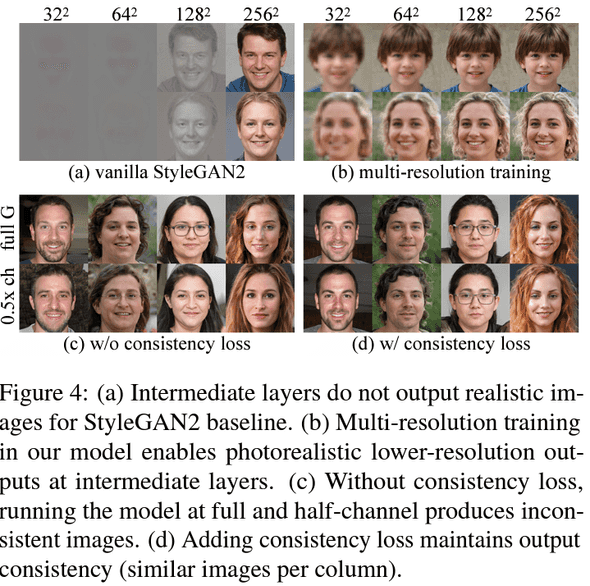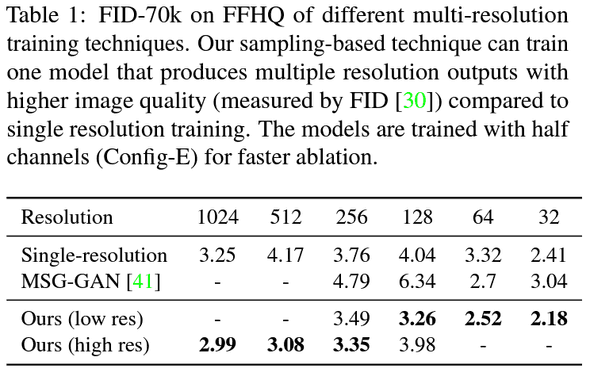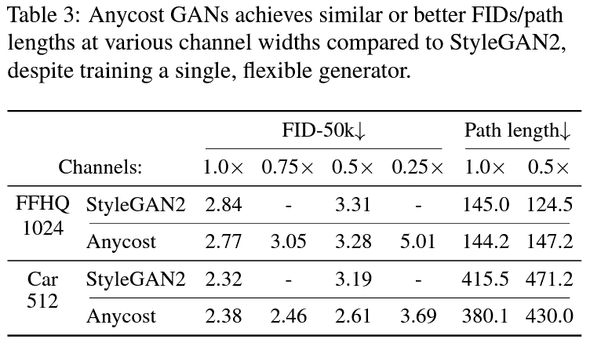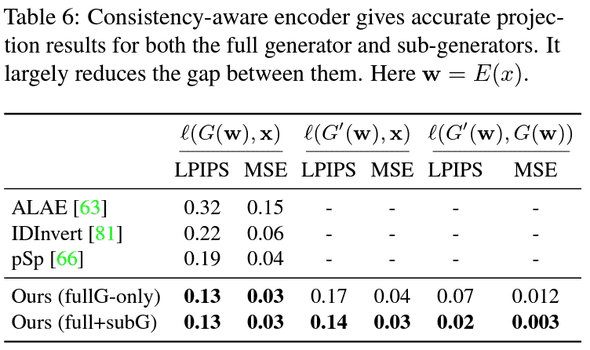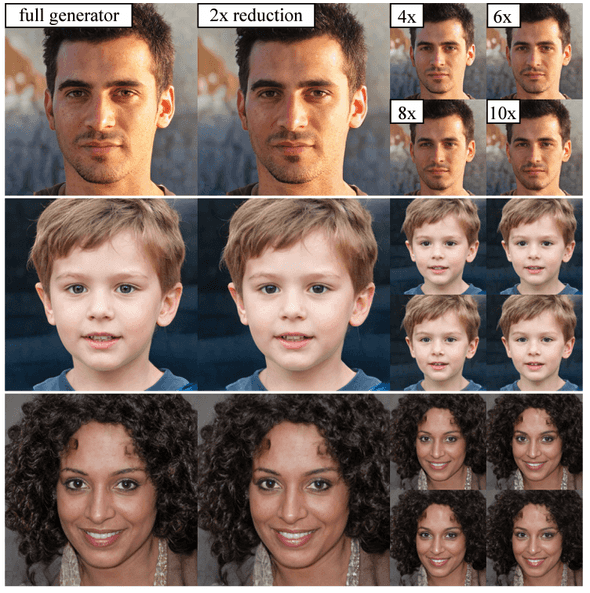TL;DR
Github에 들어가면 우측 상단에 Explore repositories에서 종종 재밌는 repositories를 추천해줘서 자주 구경 중인데, AnycostGAN도 이렇게 보다 논문까지 읽어보다 재밌어 보여서 짧게 정리해 보려고 합니다.
Related Work
Introduction
대부분의 이미지 synthesis하거나 editing 하는 모델들을 보면 엄청나게 커서 computation cost가 꽤 드는 편인데 (e.g. StyleGAN2, ...), 고성능 GPU에서 inference 해도 몇 초가 걸리기도 하다는 점을 issue 합니다. 유저들이 실시간이나 edge-device에서 사용하려면 빠르고 computation cost가 낮아야 하는데, 이런 점들을 이번 논문에서 이미지 퀄을 비슷하게 유지하면서 x6 ~ 12 빠르게 생성이 가능한 무언가를 제안합니다.
논문의 목표는 run at diverse computational costs라고 하며, 넓은 범위의 computational costs에 따른 계산(~= 이미지 생성)이 가능하다는 점 입니다. editing 같이 빠르게 수정해야할 니즈가 있는 건 low-cost(sub) generator를 사용해 preview를 보여주고, 최종 결과물을 render할 때엔 high-cost(full) generator를 사용할 수 있다고 합니다.
아래와 같이 크게 3개의 특징으로 정리해 볼 수 있습니다.
stage-wise trainingto stablize the process- a generator가 여러 configurations에 대해 minmax optimization하는 건 pretty challenging한 일
- two types of
channel configurations- uniform channel reduction ratio
- flexible ratios
consistency-awareencoder &iterative optimizationfor image projection- optimize reconstruction loss for the both generators
Architecture
위에는 AnycostGAN의 전반적인 flow.
Learning Anycost Generators
아래는 다른 구현체들과 AyncostGAN architecture를 diff한 이미지
Multi-resolution training
이미 이전에 StackGAN, StyleGANv2처럼 diverse resolutions 이미지를 생성하는 연구가 있었지만, low-resolution과 output (high-resolution) 이미지가 자연스럽지 못하다는 문제를 듭니다.
그래서 multi-scale objectives를 추가해서, gradually 여러 해상도의 좋은 퀄 이미지를 얻을 수 있다고 합니다.
multiple-resolutions로 학습할 때, MSG-GAN에서 채택한 방식처럼 학습하면 (주로 large-scale datasets에서) fidelity degradation이 발생할 수 있다고 합니다 (single-resolution으로 하는 방법 보단).
그래서 sampling-based objective를 제안했는데, 한 step에 하나의 resolution에 대한 imsage를 sample해서 사용한다고 합니다. 또한, low-resolution image를 생성할 땐 network의 중간 layer를 output으로 사용했다고 합니다.
아래는 multi-scale objectives를 추가했을 때 해상도 별 이미지 퀄리티를 확인할 수 있는데, 확실히 각 resolution-level(?)별로 퀄리티가 훨씬 좋아지는 점이 있습니다. 또한, consistency term도 추가해 low/high resolution 간 perceptual도 훨씬 좋아진 걸 확인할 수 있네용
Adaptive-channel training
computational cost를 줄이기 위해 channel 부분도 variable 하게 만듭니다. 각 layer 마다 다른 channel multipliers를 가지게 하는데, uniform or flexible한 전략을 소개합니다.
각 training iteration에, channel multiplier을 sample하고, sample한 부분만 update한다고 합니다.
마지막으론, 모델을 초기화할 떈 이전 stage에서 학습한 weight를 사용하고, magnitude of kernel에 따라 conv layer의 channel을 sort했다고 합니다.
요 정도로 학습하면 어느 정도 잘 학습하지만, 논문에서 목표하는 정확한 preview (full image와 consistency가 있어야 함)를 생성하는데 문제가 있다는 점을 언급하며 consistency loss term을 추가합니다.
consistency loss=MSE loss+LPIPS loss
Generator-conditioned Discriminator
각각 다른 sub-generators의 channels과 resolutions을 한번에 학습해야 하는데, single discriminator를 사용하는건 성능에 영향을 줄 거라 생각해서 generator-conditioned discriminator를 만들었다고 합니다.
여러 직관적인 방법이 있겠지만, 설계 및 성능상 영향을 줄수 있어서 learning-based 접근 방식으로 conditioning을 구현했다는데, 위에 이미지 Figure3(c)에 4차원 짜리 vector (one-hot encoding한) g_arch (for the ratios)을 concat해 준다고 합니다.
Searching under different budgets
한 줄 요약으로 evolutionary search로 적절한 budget내에서 configuration을 찾을 수 있다고 캅니다.
Image Projection w/ Anycost Generators
Consistency-aware image projection
editing task를 진행하려면 먼저 image를 latent space로 projection해야 하는데, 2 가지 방식이 있을 수 있습니다.
-
Encoder-based projection
-
Optimization-based projection
with iterative gradient descent
하지만 랜덤하게 sampled된 latent code로 부터 이미지를 생성하면, predicted/optimized 는 prior distribution을 follow하지 못할 수 있습니다.
그래서, full generator에서도 동작해야하고 randomly sampled된 latent code에 대해서도 잘 동작할 수 있게 objective를 수정했다고 합니다.
Image-editing with anycost generators
latent code를 edit하기 위해서 간단하게 를 에 더해줍니다. 즉, 다음곽 같이 새로운 이미지를 생성합니다.
Performance
single vs multi-resolution on FFHQ
FFHQ dataset에서 FID-70k를 측정했는데, sampling-based multi-resolution으로 학습을 하니 single resolution method보다 좋은 FID를 얻었네요.
Budgets
다음은 성능대비 costs를 benchmark한 plot인데, 다른 methods들 보다 가성비가 좋다는 것도 보여줬습니다.
StyleGANv2 vs AnycostGAN
성능도 comparable하게 가져가고 있다는 점도 흥미롭네요
Consistency-aware encoder benchmark
consistency-aware term도 추가하면서, , 의 consistency도 metric상 꽤 좋게 나옵니다.
Generated samples
Conclusion
갠적으로 real-world에서 user가 사용할 수 있는 형태를 고려한 연구라 더 재미있게 읽었고, adaptive-channel을 사용하고 이걸 잘 훈련하는 idea도 멋지다 생각했어요. 또한, 다른 stabilization methods들도 make sense하고 흥미로운 논문이었습니다. 뭔가 Nvidia에서 나온 논문처럼 benchmark하고 samples이 rich 해서 더 좋았던 거 같아요.
결론 : 굳굳굳


